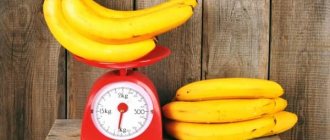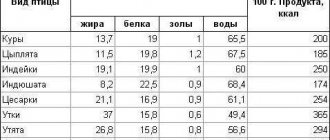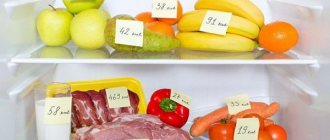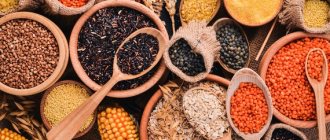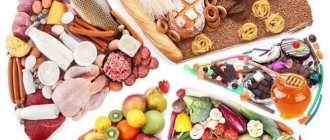An important part of any person’s diet are foods containing carbohydrates. Not only fats and proteins, but also carbohydrates take an active part in the metabolic processes occurring in the body. If a person feeds his body with proteins, fats and carbohydrates in the right quantities and in a balanced manner, then he can forget about serious metabolic disorders once and for all!
Carbohydrates are the main source of energy! They take part in the breakdown of fats and the structure of membranes at the cellular level, stimulate brain function, promote the synthesis of nucleic acids and amino acids, help the body cleanse itself of toxins and waste, protect it from many types of bacteria and viruses, and strengthen the immune system.
But not all foods containing carbohydrates are beneficial for our body. What plant foods contain carbohydrates that are beneficial for the human body? What types of carbohydrates exist and how do they differ from each other? Today we will try to find answers to these and many other questions regarding carbohydrates!
Table List of foods and their content of complex carbohydrates
In order for the body to work smoothly and have enough nutritional energy for the whole day, in order to avoid thoughtless consumption of fast sugars, it is worth knowing your personal standards for the consumption of carbohydrates in grams.
- sedentary work and lack of physical activity – 3 – 4 g;
- active lifestyle – 4 – 5 g;
- Professional sports and especially heavy loads require the use of up to 8 grams.
Complex carbohydrates are presented below in the form of a list of products and a table to make it easier to find information.
Fruits and berries
In addition to providing energy, such treats saturate the body with vitamins and minerals.
| Name | Number of carbohydrates in 100 grams of product |
| Lemon, sea buckthorn | 3 |
| Strawberry, cherry plum, grapefruit, strawberry | 6 |
| Currant | 7 |
| Mandarin, orange, apricot | 8 |
| Pears | 9 |
| Cherries, plums, sweet cherries, peaches, apples, plums | 10 |
| Pineapple, persimmon | 12 |
| Grape | 16 |
| Bananas | 21 |
Vegetables and greens
It is from plant foods that fiber and pectin come, so it is important to monitor the amount of vegetables in your diet. But it is also important that such food be both raw and cooked.
| Name | Number of carbohydrates in 100 grams of product |
| Radishes, asparagus, spinach, lettuce and iceberg | 3 |
| Beans, cabbage, tomatoes | 4 |
| Sweet peppers, cucumbers, eggplants | 5 |
| Dill, parsley, basil, oregano, oregano | 8 |
| Olives, onions and red onions, beets | 10 |
Porridge, dairy products
- Dairy products.
Despite the fact that milk and derivatives are fast carbohydrates, they should be included in the daily menu in order to consume calcium and vitamins.
| Name | Number of carbohydrates in 100 grams of product |
| Butter, soft homemade cheese | 2 |
| Kefir, yogurt without sweeteners or additives, sour cream | 4 |
| Whole milk | 5 |
| Low-fat cottage cheese | 5 |
| Semi-hard cheeses | 8 |
It is important to note that the dairy products listed in the tables are natural products without any artificial additives and not made from reconstituted milk. This group usually includes farm dairy products
- Cereals.
Unpolished and unheated cereals should be present in the diet every day, because they are a source of large amounts of substances necessary for good digestion.
| Name | Number of carbohydrates in 100 grams of product |
| Green buckwheat, millet, red rice | 68 |
| Barley, durum pasta | 71 |
| Corn | 75 |
Legumes and grains
| Name | Number of carbohydrates in 100 grams of product |
| Beans | 4 |
| Beans | 8 |
| Green peas, lentils | 20 |
Beverages
Most fruit juices contain many essential polysaccharides.
| Name | Number of carbohydrates in 100 grams of product |
| Apple juice | 25 |
| Beet juice | 30 |
| Banana smoothie | 90 |
What foods contain simple carbohydrates? Table
A high content of quickly digestible carbohydrates is observed in the following products:
- natural honey, syrups, fresh jam;
- confectionery and flour products;
- rice or wheat flour;
- pasta;
- sweet and carbonated drinks;
- sweet fruits, berries and dried fruits.
Foods with fast carbohydrates are harmful to the body, a table of which is compiled in descending order. Therefore, you should exclude them from your diet or limit your consumption.
| Products | How many carbohydrates are contained in 100 g of product, g |
| Sugar | 99 |
| Caramel candies | 88,5 |
| Corn flakes | 83 |
| Natural honey | 82 |
| Waffles with fruit jam | 81 |
| Semolina | 74 |
| Marmalade sweets | 72 |
| Homemade jam | 70 |
| Date fruits | 69 |
| Sprouted rye seeds, cookies | 67 |
| Dried grapes | 65 |
| Popcorn | 63 |
| Milk chocolate | 60 |
| Instant noodles | 57 |
| Bakery | 55 |
| Cakes, candies with chocolate | 54 |
| Chips | 53 |
| Cookie | 50 |
| White bread | 49 |
| Cakes and pastries | 46 |
| Carbonated sweet drinks | 42 |
| Dried plums | 40 |
| Donuts, apple pie | 39 |
| Eclairs | 36 |
| Alcohol | 20-35 |
| Ice cream | 25 |
| Boiled white rice, pizza | 24 |
| Fried potatoes, canned corn | 23 |
| Sandwiches with sausages | 19 |
| Boiled potatoes | 17 |
| Bunch of grapes | 15 |
| Boiled beets | 10 |
| Freshly squeezed juice from oranges, apricots | 8 |
| Pumpkin | 7 |
| Melon, watermelon, boiled carrots | 5 |
To properly adjust your diet, it is recommended to consult a nutritionist. The specialist will explain which foods contain simple carbohydrates, and the table will allow you to correctly create a menu for the day.
List of simple carbohydrate foods
- Sugar. This product contains quickly digestible carbohydrates and is characterized by high energy value. Sugar has no biological significance for humans, and its excessive consumption leads to caries and the development of obesity.
Product name GI Proteins (g) Fat (g) Carbohydrates (g) Calories (kcal) Brown sugar 70 — — 98,63 389,33 Rafinated sugar 75 — — 99,9 400 Beet sugar 75 — — 99,9 399 Malt sugar (maltose) 70 — — 95,3 362 - Confectionery. Cakes, eclairs, cookies, waffles and other confectionery products contain simple carbohydrates, which charge the human body with energy and also improve his mood. Systematic consumption of confectionery products provokes the development of diabetes, gastrointestinal diseases and obesity.
Product name GI Proteins (g) Fat (g) Carbohydrates (g) Calories (kcal) Halva 70 11,6 29,7 54 516,2 Cracker 70 7,4 9,4 73,1 407 Waffles 75 3,2 2,8 81,1 342,1 Sherbet 70 7,3 14,7 66,2 417 Biscuit 70 5,9 0,8 56,3 258 Donuts 85 6,4 22,8 43,1 403 Marshmallow 65 0,8 0,1 79,8 326 Jam 70 0,4 0,3 68,2 254 - Potato. Raw potatoes contain B vitamins, carotene, magnesium, calcium, iron, and folic acid. Potatoes are also rich in starch, which is poorly digestible and has a high calorie content. Heat-treated potatoes are not a dietary dish and contain “empty” calories.
Product name GI Proteins (g) Fat (g) Carbohydrates (g) Calories (kcal) Fried potato 95 2,8 9,5 23,4 192 Potato casserole 90 3 53 16,6 128 Boiled potatoes in jackets 65 2,4 0,4 11,5 82 - Rice. This product is used in dietary nutrition as it does not contain cholesterol and is a good source of carbohydrates. Nutritionists do not recommend consuming large quantities of refined white rice. Its excess in a person’s daily menu leads to the development of diseases of the circulatory system and diabetes mellitus. It is most rational to use brown or unpolished rice for cooking.
Product name GI Proteins (g) Fat (g) Carbohydrates (g) Calories (kcal) Rice porridge is sticky in water 70 1,5 0,1 17,4 78 Boiled brown rice 55 2,2 0,2 21,9 101 Boiled rice, polished 70 2,4 0,2 24,9 113 Rice pudding 85 2,95 3 22 127 Rice milk 85 1,2 0,8 10 52 Rice flour 95 5,95 1,42 77,73 366 Rice noodles 75 3,44 0,56 81,64 364 - Cornflakes. Corn flakes contain a large percentage of carbohydrates, as well as preservatives that “clog” our body with harmful compounds. Regular consumption of corn flakes in combination with sugar syrup, honey or yogurt increases a person's body weight and leads to obesity.
Product name GI Proteins (g) Fat (g) Carbohydrates (g) Calories (kcal) Cornflakes 85 9 1 81 379 Corn grits 70 8,3 1,2 71 328 Corn syrup 116 — — 77,59 286 Hominy 70 2 1 21 92 - Chocolate. This product is not only a tasty treat, but also a natural medicine. With its help, you can increase the number of blood cells, as well as prevent the development of senile dementia in old age. Nutritionists advise consuming no more than 25 g of chocolate per day.
Product name GI Proteins (g) Fat (g) Carbohydrates (g) Calories (kcal) Bitter chocolate 25 5,4 35,3 52,6 540 Milk chocolate 35 6,9 35,7 52,4 550 Chocolate eggs "Kinder Surprise" 35 8,6 35,5 52,6 564 White chocolate 38 4,2 30,4 62,2 541 Chocolate bar 75 13,51 21,39 45,84 492,7 - Fruits and berries. These products are a natural source of easily digestible simple carbohydrates. They contain vitamins and minerals that are valuable and essential for the human body.
Product name GI Proteins (g) Fat (g) Carbohydrates (g) Calories (kcal) A pineapple 65 0,4 0,2 11,5 49 Bananas 60 1,5 0,1 21 89 Dates 146 2 0,5 72,3 306 Raisin 65 1,8 — 66 271 Watermelon 72 0,7 0,2 8,8 40 Melon 60 0,6 — 9,1 39 Persimmon 55 0,5 0,3 13,5 55 Mango 55 0,5 — 13,2 67 - Natural honey. Honey contains glucose and fructose. These simple carbohydrates provide the human body with powerful energy. Honey is completely absorbed in the body. It is not recommended for use by people who are prone to allergies.
Product name GI Proteins (g) Fat (g) Carbohydrates (g) Calories (kcal) Linden honey 60 0,3 — 82,4 304 Buckwheat honey 60 0,51 — 76,77 301 Rapeseed honey 65 0,8 — 81,5 309 - Carbonated drinks. Soda contains sugar, flavorings and acids. Regular consumption of such drinks leads to obesity, diabetes, destruction of tooth enamel and the development of cancer.
Product name GI Squirrels Fats Carbohydrates Calories "Cosa-Cola" 70 — — 10,6 42 "Fanta" 70 — — 11,7 47 "Sprite" 70 — — 10,2 42
Tomato:
No one doubts the excellent taste of tomatoes. However, their advantages are not limited to this. They contain a large number of substances beneficial to the body, including protein, glucose, fructose, sucrose, mineral salts and carotene.
Without exaggeration, the tomato can be called a record holder among vegetables for the content of iron salts. Malic and citric acids, which are part of tomatoes, help increase appetite, proper functioning of the stomach, and also suppress the activity of pathogenic bacteria in the intestines.
No less useful is tomato juice, 250 ml of which contains 1 mg of carotene, which is converted into vitamin A in the human body. People who regularly consume tomatoes in summer and autumn will feel better in winter and spring than those who do not.
There is a simple way to determine whether the body has enough vitamin A. To do this, you need to enter a dark room from a light room and calculate how long it takes your eyes to get used to the darkness. If it takes more than 6 seconds, then the body is deficient in vitamin A.
Tomatoes are rich in vitamins B1, B2, B6, C, PP, K, folic and pantothenic acids, biotin, inositol. They are recommended for dietary and baby food. Tomatoes are indispensable for obesity, salt metabolism disorders, diseases of the cardiovascular system and gastrointestinal tract.
An important property of tomatoes is that they contain a powerful antioxidant - lycopene, which helps in the treatment of many diseases. By preventing DNA mutation, it protects the body from cancer and delays the process of cancer cell division. It should be borne in mind that this substance is well absorbed in combination with fats, so tomatoes are especially useful with vegetable oil.
Tomatoes should be present in the diet of people at risk for cardiovascular diseases, as lycopene prevents their development. Tomatoes are also useful for those who are susceptible to depression. Numerous studies have shown that their regular use has a beneficial effect on the activity of the central nervous system, promotes good mood and vigor. The phytoncides contained in this vegetable have antibacterial and anti-inflammatory effects.
[custom_ads_shortcode2]
Fast carbohydrates: what are they and what do they eat with?
Carbohydrates, which consist of a small number of molecules, no more than two, are absorbed by the human body at a very high speed and are called fast or simple carbohydrates. Most often they have a sweet taste and quickly dissolve in water.
We recommend: Measures to prevent diabetes mellitus
Advice! Fast carbohydrates have a high glycemic index. This suggests that it only takes a couple of minutes for them to turn into blood sugar. Once this happens, there will be a surge of energy and insulin levels will increase.
Man has been evolving for several thousand years, but despite this, his body has hardly changed, as well as his metabolism. However, the food that people consume has changed. It is not easy to find fast carbohydrates in nature.
To obtain sugar in the amount in which it is found in a liter of carbonated drink, you need to eat more than one meter of sugar cane. In addition to sugar, simple carbohydrates are naturally contained in honey, but its use by our ancestors was limited.
Why should you not consume fast carbohydrates?
As mentioned above, simple carbohydrates do not take much time to digest. After absorption, blood sugar levels rise. To use excess sugar, the body synthesizes insulin, which uses these calories at the moment or converts them into subcutaneous fat.
An increase in blood sugar is followed by a decrease, which in turn makes a person feel tired. This feeling can be perceived as hunger. Often after this you want to eat something sweet to increase your blood sugar. In most cases, it ends in overeating and obesity.
Most often, by constantly consuming simple carbohydrates, a person is deprived of the ability to properly absorb glucose. The human body simply stops “seeing” the sugar in the blood, which is why the ability to utilize it is lost. As blood glucose levels rise, metabolism deteriorates.
The disease that follows the above is called “type 2 diabetes mellitus.” It progresses due to high consumption of simple carbohydrates and a sedentary lifestyle. This disease leads to obesity and weakness.
List of foods high in fast carbohydrates
- Granulated sugar is the most common product containing a huge amount of simple carbohydrates. It is difficult to find a person who does not add sugar to tea, coffee and similar drinks. The reason is that the price is not high and it is very easy to get.
- Drinks with added sugar are products containing record amounts of fast carbohydrates. One liter of such a drink may contain more sugar than a person needs to consume per day. It is important to consider that such drinks include juices, nectars and compotes.
- Sweets are a product that contains calories that are not at all typical for human metabolism. In addition to sugar, which they contain in huge quantities, you can find wheat flour, which in turn contains gluten, which is harmful to your health and figure.
- Honey is a product that is almost no different from sugar. The body reacts to honey in the same way as to sugar. It is worth remembering that it does not matter what color the sugar is, because in addition to color, they differ from each other only in taste.
- Preserves and jams. Fresh fruits are famous for their beneficial properties. They contain vitamins, antioxidants and fiber. However, in the form of jam or jam, fruits lose their beneficial properties.
- Sauces. To make the product tastier, sugar is added to it. Sauces are no exception. The record holders for sugar content are sour sauces, barbecue sauces and ketchups.
The main harm of fast carbohydrates is not only weight gain, but also the development of diabetes . Today, when people do not have enough time to eat normally, foods high in fast carbohydrates are taking up more and more space in our lives.
In order to maintain your health and physical fitness in excellent condition, it is advisable to reduce the consumption of simple carbohydrates to a minimum.
This is interesting
When choosing fruits in a store or market, always pay attention to their freshness. There should be no damage to the fruits themselves, and there should be no liquid in or under the packages. Before eating, be sure to wash the fruit under running water, regardless of whether you will eat it with the skin on or plan to peel it. If food is washed long before consumption, there is a chance that it will spoil faster than expected. It is best to store fruit in the bottom drawer of the refrigerator. Apples can be stored this way for up to a month. Most fruits, such as pears and bananas, should be consumed within 7 days. Cherries, strawberries and others are perishable. Fruits can be preserved for the winter by freezing or canning. It is advisable to store canned foods in a cool, dark place.
Types of carbohydrates
Organic substances from the carbon group are divided into two large groups - simple and complex. The former are also called fast or easily digestible, and the latter - slow.
Simple carbohydrates
They have a simple composition and are quickly absorbed in the body. This feature of carbohydrate leads to a sharp increase in blood glucose. The body's reaction to the consumption of simple carbohydrates is a large release of insulin, the hormone responsible for the production of pancreas.
The sugar level under the influence of insulin decreases below the standard norm. Thus, a person who has recently eaten foods rich in simple carbohydrates begins to feel hungry quite quickly. In addition, the conversion of sugar molecules into subcutaneous fat occurs in a ratio of one to two.
If you abuse food that is rich in fast carbohydrates, this will lead to the following adverse consequences:
- constant feeling of hunger and desire to snack;
- insulin damage to blood vessels;
- rapid wear of the pancreas;
- increasing the risk of developing diabetes.
These negative effects became the main reason that these carbohydrates began to be called harmful or undesirable.
Complex carbohydrates
Slow organic compounds, such as fiber, glycogen, starch, act on the body in a completely different way. The substances included in this group have a complex composition, which means their absorption rate is much lower than that of fast ones. These compounds have high nutritional value and therefore the sugar concentration practically does not increase, and, consequently, a person feels full for a long time.
Since the concentration of sugar is not too high, the liver has time to process it. This means that it is almost completely converted into energy resources, and is not stored as fat. Thus, complex carbohydrates do not cause any harm to the body, that is, they are beneficial.
Cucumbers and tomatoes in the diet of those watching their figure
As it has already become clear after finding out the caloric value of cucumbers and tomatoes and their effect on the body, these two vegetables are indispensable for those who want to lose weight or simply control the correctness of their own nutrition. The only thing that should be immediately taken into account is the limitation on the number of cucumbers eaten in case of increased stomach acidity, and tomatoes in case of allergic reactions and kidney problems. Otherwise, in the absence of the above diseases, there are no prohibitions on them, especially during the period of weight loss.
Even eaten at night, at a time of severe hunger, they will not harm the process of getting rid of extra centimeters, on the contrary, they will contribute to the burning of fat. Cabbage, which is the last element of the combat dietary trio, has approximately the same effect. Therefore, everyone who is losing weight should keep in mind the combination that forms a healthy and light salad, which has a low calorie content: tomatoes, cucumbers and cabbage.
They are joined by onions, garlic, radishes and herbs, and the whole mixture is seasoned with low-fat sour cream. The number of calories in a salad of tomatoes and cucumbers of this type allows us to classify it into the group of dishes with negative calorie content: they do not even reach the 30 kcal level, remaining at 25 kcal per hundred grams.
You can experience the maximum usefulness of such a dish when using it with meat or fish group of products. Firstly, this will increase its satiety, allowing it to be turned into a nutritious and fairly light lunch, and, secondly, it will improve the absorption of heavier components: chicken, beef, pork or fish. Since, in addition to their low calorie content, cucumbers and tomatoes are known for their fat-burning properties, they will not allow these “harmful parts” of meat to be deposited where they are not needed. After all, splitting affects not only the vegetables themselves, but also the products taken with them.
category Food and drinksLow-calorie productsVegetables are irreplaceable sources of natural energy and various microelements and vitamins. Their constant consumption leads to the fact that the body adjusts itself, digestion and the functioning of many internal organs improves. And also - vegetables help digest such coarse and heavy types of food as barbecue or scrambled eggs with bacon, for example, and many others. It’s not for nothing that in the Caucasus people eat a lot of vegetables along with meat. And the fiber contained in them thoroughly cleanses the gastrointestinal tract from unnecessary processed residues. We will tell you how many calories are in cucumbers and tomatoes and how they are beneficial for the human body in our article.
[custom_ads_shortcode2]
Types of complex carbohydrates
Polysaccharides or long carbohydrates are large chains of compounds that, when broken down, can provide much more energy than simple ones. Complex carbohydrates are digested slowly and for a long time, without sudden spikes in insulin. After taking them, a person remains full for a long time, full of strength and vigor.
Fiber, starch and glycogen are complex carbohydrates. Each of them is an important component for building a harmonious diet, and ideally it should be a combination of all three types. Let's take a closer look at the features of each.
Starch is considered unique and the most valuable; about 80% comes from healthy carbohydrates from starchy foods. Compared to simple compounds, the product has longer chains consisting of glucose molecules. Similar polysaccharides are found in foods such as cereals, pasta and baked goods, rice and cereals, green beans and potatoes. There are also processed forms - these are short polymers of glucose and maltodextrin. They dissolve perfectly in water, which facilitates immediate entry into the bloodstream after administration.
This product has another big advantage - the absence of a side effect in the form of bloating. Complex compounds are recognized as the best sources of energy, so every athlete should add them to their diet.
Fiber – This substance is usually very neglected by many people. There is a lot of it in fruits and vegetables, legumes and grains, as well as nuts. Its structure is not a starchy polysaccharide, but in common parlance it is dietary fiber.
Has a number of features:
- there is no possibility of digesting fiber due to its resistance to digestive enzymes;
- reduces the risk of oncological pathologies of the colon, diabetes mellitus and diseases of the cardiovascular system;
- lowers levels of “bad” cholesterol;
- promotes the excretion of bile acid.
Fibers can be soluble or insoluble. Agree, not many people know which carbohydrates are insoluble in water and why they are needed. In the meantime, there are a number of advantages for athletes:
- The insoluble group helps improve the digestion process by slowing down the hydrolysis of starch, and also helps remove breakdown products and slow down the absorption of glucose.
- A group of soluble fibers slow down digestive activity and lower cholesterol levels. Like insoluble fiber, it slows down the absorption of glucose.
We recommend: Chemistry formula of sugarGestational diabetes
Glycogen - the chain contains several glucose molecules. Immediately after eating, glucose enters the bloodstream, the excess of which is stored in the form of glycogen. For example, during physical activity, glucose levels drop, the body begins to break down glycogen with the help of enzymes, returning glucose levels to normal. Even during the training process, all organs can produce energy in sufficient quantities.
The main places where glycogen accumulates are muscles and liver. The total amount varies in the range of 300-400 g. In the process of building the body, glycogen from muscle fibers is extremely important.
Under the influence of physical activity, fatigue occurs due to the depletion of stored glycogen. In this regard, one and a half to two hours before the start of training, you need to consume foods high in carbohydrates in order to replenish glycogen reserves.
The table provides specific examples of each type of long connection.
| Polysaccharides | ||
Starch:
| Soluble Fiber:
| Insoluble fiber:
|
Complex carbohydrates based on fiber
What exactly is fiber and why is it important?
Fiber is a nutrient that, like water and mineral salts, does not provide the body with energy, but plays a huge role in its functioning. Those. carbohydrates (and therefore calories) from fiber are not absorbed, eat it calmly!
Grain products, fruits, and vegetables are characterized by a high fiber content.
However, in addition to the total amount of fiber, its quality matters. Coarse fiber breaks down well in the intestines and is better absorbed, serving as a “brush” for the gastrointestinal tract, for example, fiber from potatoes and vegetables. Fiber helps remove cholesterol from the body.
What are simple and complex carbohydrates?
Carbohydrates are the main source of energy for our body. For example, the brain takes energy only from carbohydrates. But in the modern world there is a problem: there are too many carbohydrates in our diet. So many that the body is not able to convert them all into energy. Excess carbohydrates are not excreted as we would like, but are stored as fat. Today, the number of overweight people is constantly growing, and this applies to all social classes and all ages.
Pay attention to modern schoolchildren. Almost a quarter of them already have problems with excess weight
And the main reason for this phenomenon is excess carbohydrates in the diet. Excess, of course, simple carbohydrates...
Simple carbohydrates are monosaccharides, simple in structure, easily and quickly digested. When you eat food containing a lot of simple carbohydrates, a lot of sugar (glucose) enters your bloodstream. A lot for one time... Insulin, a hormone of the pancreas, regulates the amount of sugar in the blood. It quickly removes excess glucose so that it does not have time to harm your health. And all excess is processed by the liver into fat deposits, which can be unlimited. The body can store only 2000 kcal as glycogen in the liver. Glycogen is primarily used up in times of famine.
Simple carbohydrates are only good when eaten before strength training. Then the excess energy will be spent.
Complex carbohydrates are polysaccharides. More complex compounds of carbon and water. They take longer to digest; sugar does not enter the blood all at once, but gradually, in small portions. This helps keep you feeling full longer, avoiding sugar fluctuations and insulin spikes. The body will receive the necessary energy over a long period of time, and not all at once, as when consuming simple carbohydrates.
For health, you need to give preference to complex carbohydrates!
How many calories are in cucumbers and tomatoes?
It is worth remembering right away that these vegetables belong to the group of those that have negative calorie content. Cucumbers and tomatoes are, by and large, the leaders in this list, since they not only by “weight” are kept within the limits of 30 kcal per hundred grams, but also do not exceed 20 kcal for the same volume. This allows you not to be afraid to snack on such products even before bed, if you are completely unbearable to sit on kefir alone, drunk at eight o’clock.
True, such impunity is determined not only by the calorie content of cucumbers and tomatoes, but also by their effect on the body. If the indicator itself - 14 kcal and 19 kcal for each - still carries some kind of “weight”, then the work of these same calories significantly covers their already low value.
Despite the fact that cucumbers contain as much as 78% carbohydrates, and this may at first scare someone who is thinking about the energy value of foods for the first time, a much more significant point is the proportion of water in this vegetable. It is precisely this that is decisive: as much as 95%. But, of course, it is not comparable to the water that flows through pipes, given the impressive list of chemical elements: there are many vitamins, among which stand out A, C, B9, K, PP, and a huge set of microelements with the leading aluminum, as well as fluorine , copper, iodine, chlorine, phosphorus, potassium, magnesium and calcium.
In addition, do not forget about fiber, which perfectly absorbs harmful substances and removes them from the intestines. Due to its chemical composition, cucumber is indispensable for kidney and liver problems. But the most valuable thing, besides the calorie content, in a cucumber - a tomato does not have such properties, but is distinguished by other qualities - it is tartronic acid.
It is especially appreciated by those losing weight, because it prevents the formation of fat deposits in problem areas. And the feeling of fullness that, in principle, a very light vegetable gives, is an excellent bonus. That is why, even if a salad with cucumbers, tomatoes and sour cream had a high calorie content, it could be consumed without worrying about your figure: in tandem, these two products fill you up instantly, and therefore you won’t be able to eat a lot and eventually gain kilograms.
As for the second component of the already mentioned dish - tomato, its “weight” is a little more carbohydrates - already 84%, but there is still a lot of water in it: 93%, and therefore there is no need to be scared, like a cucumber. In terms of vitamin composition, it is close to cucumber, also containing a significant proportion of vitamins K, C, B9 and A, as well as beta-carotene and biotin. Among the mineral substances, the picture is slightly different: in addition to potassium, sodium, magnesium, calcium, chlorine, phosphorus and copper common with cucumber, rubidium and boron are present here. In addition, just like its green pimply counterpart is distinguished by tartronic acid, the tomato boasts high antioxidant properties and the ability to break down fats due to the lycopene it contains. For this reason, tomato is often included in diet and diabetic menus, as it can lower blood sugar and cholesterol levels.
As a result, the calorie content of a salad of cucumbers, tomatoes and sour cream, even with the relative fat content and apparent negativity of the latter, is, by and large, more beneficial than harmful. Moreover, it is better to cook it with low-fat sour cream, and not with vegetable oil, to achieve maximum usefulness and ease. In addition, the sour cream variation is suitable for a separate diet, where only carbohydrates are present, but the butter version is suitable for a protein-carbohydrate diet.
In this case, the calorie content of cucumbers and tomatoes with onions and sour cream will barely reach 30 kcal per hundred grams. And with oil it will show about 95 kcal per hundred grams. The difference, it should be noted, is significant, although not very critical.
[custom_ads_shortcode1]
How does carbohydrate metabolism occur?
Food containing complex carbohydrates in the gastrointestinal tract can be broken down into simple compounds, namely glucose, after which it is absorbed into the blood. A hormone (insulin) is synthesized, which converts the product into glycogen. The process lasts until blood glucose levels stabilize.
Glycogen reserves are located in muscle fibers and liver cells. During training, reserves in the muscles are depleted, and reserves in the liver are aimed at maintaining the required level of glucose in the blood. The norm is considered to be from 80 to 120 mg/dl.
In case of a lack of nutrients, glycogen from the liver is converted back into glucose and enters the blood - all this is necessary to maintain the normal functioning of the body.
What happens when you have too many carbohydrates?
If complex carbohydrates enter the body in excess, this helps to increase insulin production, no matter what foods are consumed. Overload of the pancreas leads to depletion of its cells, which, if there is a tendency, can cause diabetes mellitus. A completely unpleasant bonus to everything will be the deposition of fat with an excessive concentration of glycogen.
When complex carbohydrates are consumed in excessive amounts and are poorly chewed, fermentation processes are started in the intestines. This is not only bloating and discomfort during training, but also poisoning the body with toxins from the intestines. In medicine this is called fermentative dyspepsia.
What happens when there is a lack of carbohydrates
If, when planning your diet, you strictly cut carbohydrates for a long time, this can lead to irreversible metabolic disorders. The body will not receive important energy from food, so it begins to waste glycogen from the liver, which provokes a disruption in its activity.
When there are no food sources of carbohydrates, the process of protein breakdown is activated to obtain the necessary energy. As a result, the destruction of muscle mass begins, which was built so long and diligently in the gym. It should be noted that the process also affects the heart muscle. All these factors make a long-term and grueling low-carb diet extremely detrimental to a person.
Low levels of glucose in the blood provoke exacerbation of hunger, and prolonged deficiency leads to weakness and lack of energy, nausea and sweating, headaches and systematic dizziness, tremors and tachycardia. This is called hypoglycemia, which is made worse by insulin resistance (metabolic syndrome).
Cucumber and tomato salad:
Wash cucumbers, tomatoes, apples thoroughly. Cut the peeled cucumbers into cubes. Wash the peeled onion, cut into strips and feathers.
Cut the apples into small ones and the tomatoes into large cubes. Mix all products with vegetable oil, season with salt and sugar to taste. Place the salad on a plate on green lettuce leaves.
Ingredients: fresh cucumbers - 250 g, tomatoes - 200 g, apple - 1 pc. , onions - 1 pc. , chopped green onions - 1 tbsp.
spoon, vegetable oil - 3 tbsp. spoons, salt, sugar.
[custom_ads_shortcode3]
What do they give and why are they so important for humans?
It is an important energy resource, one of the important components for a strong immune response, and also the material from which other vital reactions and metabolites ultimately emerge.
It has been scientifically proven that people who consume carbohydrates in sufficient quantities can boast quick reactions and good brain function. One cannot but agree that in conditions of cold or exhausting physical work, this is a real lifeline in the form of fat reserves.
But in the last decade, advertising and nutritionists have made carbohydrates almost the enemies of health, and doctors, on the contrary, talk everywhere about their irreplaceable benefits.
Calories in fresh cucumber
For those who want to get rid of extra pounds, nutritionists strongly recommend having a cucumber fasting day once a week during the season: eating only cucumbers in quantities of up to 2 kilograms. Thus, the cucumber plays a kind of cleansing role, flushing out all kinds of poisons and toxins that have accumulated there from the body. And since a cucumber consists of 90% or more liquids, you won’t get much fatter from it - it’s been tested in practice. 100 grams of fresh greenhouse cucumber contain only 11 kcal. If the cucumber is ground - up to 14, which is also an excellent result. Thus, during the fasting day - everything! — you will consume only 220 kcal, without particularly injuring the body. And the high content of potassium and water will produce a cleansing diuretic effect. However, when eating cucumbers, you should remember that they can be grown with large amounts of nitrates. In this case (whoever has such an opportunity) should grow their own product. Or peel the peel before eating - it always contains a high content of harmful substances.
[custom_ads_shortcode2]
The harm of simple carbohydrates
Consumption of simple sugars can have quite a detrimental effect on people's health. An average person needs only 62 grams of glucose for normal work and functioning. (approximately 250 kcal).
Constant consumption of refined sugar leads to the fact that sugar levels remain elevated, and the pancreas does not have time to cope with its work. Insulin is released, but it is not used in any way (leading to insulin resistance and, later, type II diabetes).
A persistent state of insulin resistance negatively impacts brain function. If this lasts for a long time, it leads to inflammation of the brain, and subsequently to memory loss.
High sugar levels, as a result of consumption of simple carbohydrates, often become a consequence of dementia in older people. The higher the sugar level, the higher the risk of developing such a disease. A small reading of 6.6/mol per liter should make you think and reduce your intake of simple carbohydrates. The indicators for the body are quite normal, but for the brain they are already destructive.
Unlimited intake of foods with large amounts of carbohydrates often leads to obesity. While the amount of simple carbohydrates consumed increases, the oxidation of adipose tissue is significantly reduced, then the fat that is not consumed is stored.
How to reduce your intake of simple carbohydrates:
- Before you make the decision to almost eliminate carbohydrates from your life, you should consult with a physician or nutritionist about the possible consequences. If you have serious illnesses, a diet without carbohydrates may be harmful.
- Adhering to the strategy of reducing simple carbohydrates in the diet, after consultation with doctors and nutritionists, it is necessary to make this way of eating a lifelong habit. If you adhere to restrictions for some time, poor health (health problems) may return.
- One of the most effective ways is to control the glycemic index of foods. If, after consuming a product, sugar quickly enters the bloodstream, then such a product has a high glycemic index, and a product that does not raise blood sugar levels so quickly and slightly is assigned a low index.
- First of all, stop consuming foods with simple carbohydrates. Avoid carbonated drinks, juices, as well as cakes and pastries.
- Switch to foods containing complex carbohydrates (which are rich in fiber).
- The second useful indicator to know is the glycemic load. This parameter indicates how quickly sugar enters the circulatory system, as well as how much fiber the product contains, which helps reduce high sugar levels.
- Change your diet in favor of more fish and meat consumption. Some types of low-carb diets emphasize red meat (high in protein but low in carbohydrates). Fish and poultry are excellent substitutes for carbohydrates.
- Try to limit portions. It is recommended to eat as much food as can fit in a glass. Eat at intervals of 5-6 times.
- Bake foods rather than fry them often. Flour batter contains unnecessary carbohydrates. To improve the taste, use herbs and spices that will give the dish a great taste.
We recommend: 15 best glucose meters
These simple principles will help you significantly reduce your intake of simple carbohydrates and make your life more fulfilling and happier.
SIMPLE CARBOHYDRATES. DISACCHARIDES
Of the disaccharides in human nutrition, sucrose is of primary importance, which, upon hydrolysis, breaks down into glucose and fructose.
